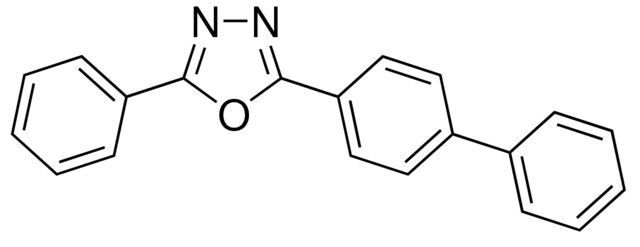2-(4-Biphenylyl)-5-phenyl-1,3,4-oxadiazole / 5 G
Safety Information
Hazard Statements
Precautionary Statements
Pictograms
Properties
| Flash Point (C) | Not available |
| Flash Point (F) | Not available |
| Melting Point | 167-169 °C (lit.) |
Product Description
2-(4-Biphenylyl)-5-phenyl-1,3,4-oxadiazole is an organic compound featuring a biphenyl group and a phenyl group attached to an oxadiazole ring. It is a solid used in chemical research and material science.
Application
2-(4-Biphenylyl)-5-phenyl-1,3,4-oxadiazole is used in the development of organic electronic materials, such as OLEDs and photovoltaic cells. It serves as a building block in the synthesis of advanced materials for electronic applications.
Articles:
- Photophysical characterizations of 2-(4-biphenylyl)-5 phenyl-1,3,4-oxadiazole in restricted geometry
Publication Date: Available online 7 May 2007
P.K. Paul, S.A. Hussain, D. Bhattacharjee
https://doi.org/10.1016/j.jlumin.2007.05.001
- Efficient organic photovoltaic cells using 2-(4-biphenylyl)-5-phenyl-1,3,4-oxadiazole as an exciton blocking layer
Publication Date: 22 October 2010
Wei Zhang, Junsheng Yu, Nana Wang, Chunhua Huang, Yadong Jiang
https://doi.org/10.1117/12.866815
- The effect of driving voltage on the electroluminescent property of a blend of poly(9-vinylcarbazole) and 2-(4-biphenylyl)-5-phenyl-1,3,4-oxadiazole
Publication Date: Available online 27 November 2008
C.C. Yap, M. Yahaya, M.M. Salleh
